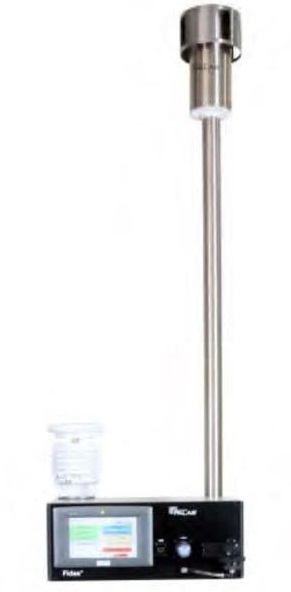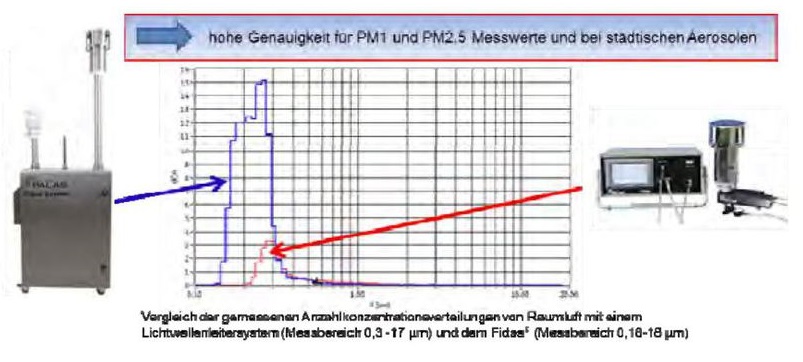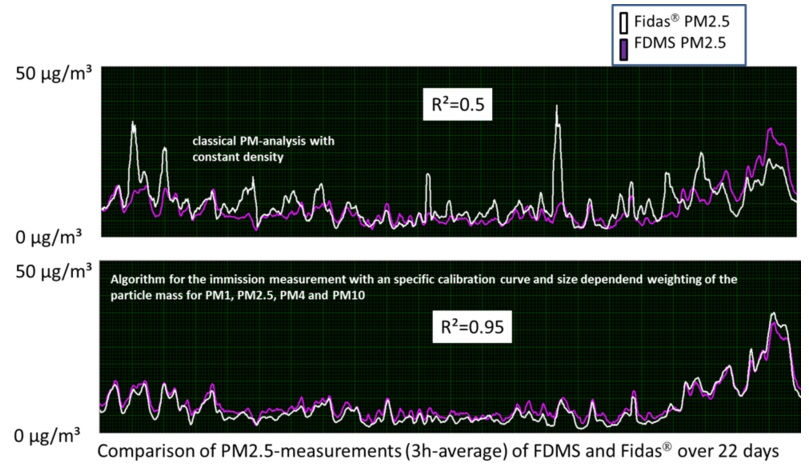Model Description

Fig. 1: Fidas® 200
The Fidas® 200 is a fine dust measurement system for ambient air quality measurements for regulatory purposes. This version is typically incorporated into an existing measurement container.
The Fidas® 200 S fine dust monitoring and immission measurement system enables the continuous and simultaneous measurement of PM1, PM2.5, PM4, PM10, TSP (PMtot), and the particle number concentration.
The Fidas® 200 system uses the recognized measurement technology of optical light scattering of single particles and is equipped with an LED light source with highly stable output and long lifetime. It is also equipped with a filter holder for the insertion of an absolute filter (47 or 50 mm in diameter). This enables a subsequent chemical analysis of the composition of the aerosol, for example.
The Fidas® 200 functions with a high volume flow of 0.3 m3/h and is equipped with a Sigma‐2 sampling head as per VDI 2119-4, which enables representative measurements even under strong wind conditions. The sampling system includes a drying system (intelligent aerosol drying system – IADS) that prevents measurement inaccuracies caused by condensation effects resulting from high humidity. In addition, a weather station provides reliable results for temperature, atmospheric pressure, and relative humidity.
In addition to the high time-resolution measurement data, the device can also be equipped with a standardized measuring head for PM2.5 or PM10 (Leckel PMX-PNK). The measurement data can be gravimetrically validated on site by weighing the filter.
Palas® offers remote maintenance and online data access for the Fidas® measurement system at www.palas.de/user.
(*) Suitability and equivalency testing is currently ongoing.
Design and function
The actual aerosol sensor is an optical aerosol spectrometer that determines the particle size using Lorenz‐Mie scattered light analysis of single particles. The single particles move through an optically differentiated measurement volume that is homogeneously illuminated with white light. Each particle generates a scattered light impulse that is detected at an angle of 85° to 95° degrees. The particle number is measured based on the number of scattered light impulses. The level of the scattered light impulse is a measure of the particle size diameter.
The lower detection limit for immission measurement was able to be reduced to 180 nm through improved optics, higher light density using a new white LED as the light source, and improved signal analysis (logarithmic analog digital converter). This enables greatly improved detection, especially of smaller particles, which are mainly found at high concentrations near roadsides (see Fig. 2).

Fig. 2: Higher sensitivity with the Fidas® fine dust measurement system for the 0.18 – 18 µm particle size range
The better the classification accuracy and the resolution capacity, the more accurate the definition of the particle size distribution.
Using a white light source enables a precise and unambiguous calibration curve to be obtained, resulting in an extremely high size resolution. The patented T-stop provides a precisely defined optical measurement volume and enables particle measurement without border-zone errors, resulting in a precise size measurement. The new digitized electronic signal analysis system enables the rapid identification and correction of coincidence, as necessary.

Fig. 3: Comparison of the algorithms for conversion of the particle size distribution by PM values
In order to convert the measured values into a mass or mass fraction, the high-resolution particle size distribution in each value is multiplied by a correlation factor that reflects the different sources (e.g. combustion aerosols, tire wear, pollen) of the environmental aerosol (see Fig. 3). A mass fraction is obtained by additionally applying the separation curve (see DIN EN 481) to the determined particle size distribution. Exact matches with gravimetric results cannot be guaranteed in every case due to the different principle of measurement (equivalence measurement method)
Multiple separation curves can be used simultaneously for the same size distribution, which enables the simultaneous output of PM10, PM2.5, PM1 (and others).

Fig. 4: Comparison of the 1-h measurement values for PM2.5 and PM10 between the Fidas® 200 S and a TEOM FDMS during a measurement campaign in a northern German city from August to November 2010
A filter holder is located downstream from the optical sensor to provide the option for a gravimetric validation of the measurement data.
Particular Advantages
- Continuous and simultaneous real-time measurement of multiple PM values
- Additional information based on particle number concentration
- Adjustable time resolution starting at 1 minute
- Light source: LED with high stability and long lifetime
- Long service life
- Low maintenance, possible to verify calibration on site
- Intuitive and easy to operate
- Reliable function
- Cloud zone via Palas server for worldwide data retrieval
- No radioactive material
- No consumables
- Reduces your operating expenses